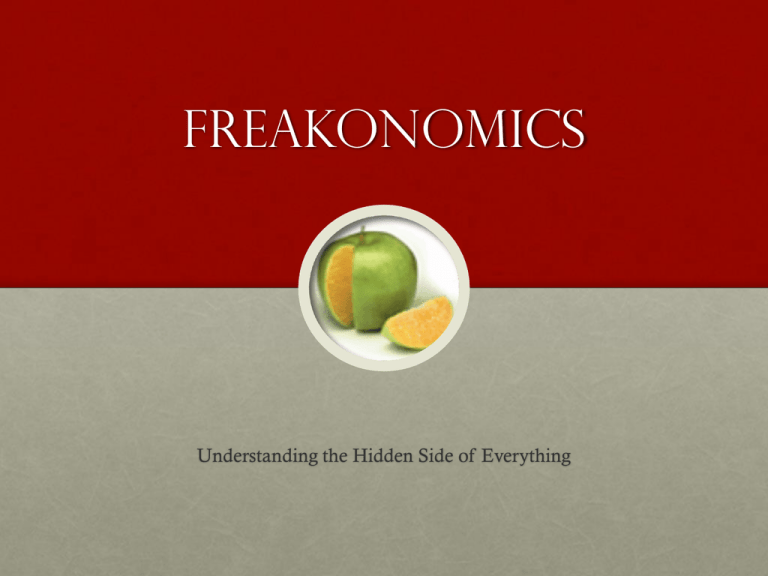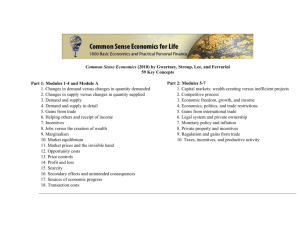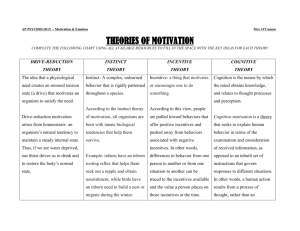1-FreakonomicsNotes Ch-1
advertisement

Freakonomics Understanding the Hidden Side of Everything Overview Themes and Fundamental Ideas • Positive vs. Normative Analysis/Economics • Positive: • Positive economics is the branch of economics that deals with the description and explanation of economic phenomena • It focuses on facts and cause-and-effect relationships and includes the development and testing of economic theories. Themes and Fundamental Ideas • Normative: • Normative economics is the branch of economics that incorporates value judgements about what the economy ought to be like or what particular policy actions ought to be recommended. • Essentially, Positive Economics attempts to explain why the economy works the way it does and Normative Economics attempts to find the best ways to control and change the economy to meet our goals. Normative Analysis Themes and Fundamental Ideas • The Nature of Scientific Inquiry • Freakonomics provides concrete illustrations of how unconventional methods of data gathering and “stand-onyour-head” ways of looking at data are often necessary to make sense of the world. • Knowing what to measure and how to measure it makes a complicated world less so. Themes and Fundamental Ideas • Incentives are the Cornerstone of Modern Life: • Economics is the study of human behavior as it manifests itself in the sometimes foggy mist of incentives. • Understanding incentives is the key to clearly understanding any human behavior. Incentives Matter Themes and Fundamental Ideas • The conventional wisdom is often wrong • The conventional wisdom that is used as an explanation for many social issues is unexamined, unquestioned and often not correct. • Q: Can you give some examples? Themes and Fundamental Ideas • Dramatic effects often have distant, even subtle causes. • “the answer to a given riddle is not always right in front of you” • Positive economic inquiry and gathering and interpreting the data that are necessary to solve a sticky social riddle is often hard (and often the only way to find the underlying cause). Chapter 1 Pre-Reading Notes What do School Teachers and Sumo Wrestlers Have in Common? VS Key Terms: • Incentive: • “a means of urging people to do more of a good thing or less of a bad thing” • Types of incentives: • Economic Incentives: • -those incentives which a person responds to in the market place. • Social Incentives: • motivate people to respond in a certain way because they care (or are worried) about how they will be viewed by others (think “Scarlet Letter”). Key Terms • Moral Incentives: • Appeal to a person’s sense of right versus wrong. • Utility: • A measure of the relative satisfaction from or desirability of consumption of various goods and services. • Marginal Utility: • The change in total satisfaction derived from acquiring one additional unit of a specific product or service. • Quid Pro Quo: • Latin- a favor or advantage granted or expected in return for something. ‘something for something’ Chapter 1 PostReading Notes What do School Teachers and Sumo Wrestlers Have in Common? Basic Economic Concepts • Incentives Matter: • Incentives and how people respond to them is a recurring theme. • “economists love incentives....The typical economist believes the world has not yet invented a problem that he cannot fix if given a free hand to design the proper incentive scheme.” • Given the proper incentives we see that most people can be induced to do things which are generally against their nature. Chapter 2 PreReading Notes How is the Ku Klux Klan Like a Group of Real Estate Agents Basic Economic Concepts • Incentives Matter: • Incentives and how people respond to them is a recurring theme. • “economists love incentives....The typical economist believes the world has not yet invented a problem that he cannot fix if given a free hand to design the proper incentive scheme.” • Given the proper incentives we see that most people can be induced to do things which are generally against their nature. • Information is Power: this chapter is all about information and the advantages it grants to those who have it vs. the disadvantages it imposes on those who do not. • Information Asymmetries: This is when one person or group has more information than another. • The Economic Value of Information: When you have a buyer and a seller, it is rare for both parties to have “perfect information”. A car loses the largest amount of its value the moment it is driven off the lot, not because it is suddenly 35% less of a car, but because the buyer can no longer be certain of how the car has been treated. • The buyer will pay extra for a car that has not been driven off the lot for the added knowledge that it has been taken care of. • Technological Change: Over time technological change has had a huge impact on how the goods we consume are produced. • While tech change takes different forms, one thing that almost all forms have in common is their effect on costs • i.e. cost tends to go down (take computers for example) • -while the power of computers has steadily gone up, their price has steadily gone down. • This chapter applies this concept of technological change to the market for information. With the creation of the internet, the cost of both providing and acquiring information has fallen dramatically. • This has had the effect of “leveling the playing field” between consumers and providers of services. • Consider the travel service, it used to be that consumers had little knowledge or ability to get knowledge about booking prices or availability. They had to, therefore, go through travel agencies (specialists who knew how to navigate this specialized field of information). • With the internet, travel prices have dropped and consumer access has increased. • Competition and Efficiency: According to the model of supply and demand, market equilibrium ensure that the net benefits from production and consumption of any good are as large as possible. • As a result, the outcome is efficient • In order to have an efficient market, however, both buyer and seller must have perfect knowledge • Thus the information asymmetries in markets such as realestate, ensure that the outcome will not be efficient (or fair). • In contrast, the increased information available to consumers via the internet for things such as life-insurance policies, has made the insurance market more efficient and therefore the outcomes in that market are more fair. Chapter 2 PostReading Notes How is the Ku Klux Klan Like a Group of Real Estate Agents Chapter Summary • The KLAN• Over time the KKK was able to exert considerable influence over the lives of those they considered “enemies,” e.g. African Americans, Jews, Catholics • When the Klan’s secret handshakes, meetings etc. were disclosed, it took away much of the Klan’s power. • Once the secrets were out, much of their membership were no longer willing to participate for fear of being exposed to the public. • Individuals can exploit informational advantages • Real estate agents have a much better sense of the market than buyers or sellers. This amounts to an info advantage. • They can combine this with the buyer or seller’s fear that they won’t find a house in order to get the best deal for themselves. • The same can be said of funeral directors, car salesmen, or mechanics.




